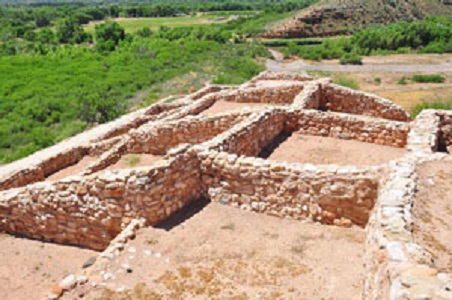
A view down from the top of the ridge-line showing rooms within the pueblo Courtesy of Tony Cyphert on Flickr
In the Verde Valley of Arizona, Tuzigoot National Monument features a Southern Sinagua pueblo and the Tavasci Marsh, a natural area along the Verde River. While the valley was more recently the site of several large copper mines, it has a deep history that goes back thousands of years. This history is just as connected to the natural resources of the Verde Valley as the mining operations of the 19th and 20th centuries.
Though much of the surrounding area is more desert-like, the Verde Valley has a permanent source of water that provided moisture for a variety of plant and animal resources for early settlers. For hundreds of years, both the river and marsh supported a number of communities in the valley, making it difficult to tell who first settled there. Possibly either the Hohokam or the Southern Sinagua were the first to live in the valley. Successful management and use of natural resources helped to grow these communities from smaller, more solitary groups to larger ones that moved from pithouses on the valley floor to pueblos along the ridgelines.
The Southern Sinagua built one such ridge-top pueblo at Tuzigoot around 1100 AD and continued to add new rooms until the 1400s. This pueblo housed about 50 people. The Sinagua would often use a large pueblo as a dwelling and community center, surrounded by additional smaller dwellings and outbuildings connected to agriculture. While the region has a mostly arid climate, the marsh and river provided a source of fresh water, wild game, fish, and turtles to the Sinagua. Although summers are hot, a very long growing season allowed for the organized cultivation of crops as a supplement to food taken from the marsh and the river. The mountains around the Tuzigoot site are rich in minerals that were mined into the 20th century. With ample water, a variety of food sources, and mineral resources, the Verde Valley around Tuzigoot was attractive for settlement.
At one time, the Sinagua lived throughout the Verde Valley. At nearby Montezuma Castle National Memorial, another group of Southern Sinagua built into the cliff, allowing them to overlook their surroundings while taking advantage of the shelter and protection offered by the stone walls of the cliff. The Sinagua at Tuzigoot, however, constructed a much more exposed pueblo along a ridge using the stone from the ridge. The pueblo visible today is really a collection of rooms grown over 400 years with new rooms built on top of older ones so that the pueblo is not of a uniform age, but has older and newer parts combined. Access to these rooms would have been primarily through holes in the roof, perhaps to minimize heat loss and gain while also providing light. The rooms mostly served as spaces for sleeping and eating by single-family groups, as the Sinagua used the roof as an additional area for living and working. On the roof, it is thought that they would perform many daily tasks such as food preparation, making stone tools, or keeping a lookout. The Southern Sinagua were particularly well known for their stone tools, including manos and metates to grind the corn that was a large part of their diet.
In addition to these stone tools, the Sinagua also created clothing and baskets they traded as part of an extensive network that reached to Mexico and the Gulf of California. This trade network provided needed supplies that supplemented the tools and objects the Sinagua constructed for themselves. Even though they lived in a setting with a range of food resources, crops, and minerals, the Sinagua acquired some goods only by trade. While other groups traded with the Sinagua for salt, copper, or argillite, the Sinagua themselves seem to have sought the decorated pottery of the Anasazi or Hopi (among other goods).
Despite the comfortable natural setting, the Sinagua left the pueblo at Tuzigoot for unknown reasons around the year 1450. Possibly the valley became overcrowded and the Southern Sinagua moved to different locations or were absorbed by other tribes. When the Sinagua abandoned Tuzigoot, they left behind many artifacts, some of which are on display in the visitor center. Today, much of the ruin at Tuzigoot has been reconstructed to provide a safe and stable environment for visitors; however, the main tower is mostly original and is open to the public. The pueblo is accessible as part of a short loop trail. An additional trail leads out to a viewing area overlooking the marsh that was so important to the Sinagua.
Last updated: June 10, 2024
